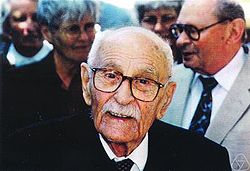Top Qs
Timeline
Chat
Perspective
Leopold Vietoris
Austrian topologist From Wikipedia, the free encyclopedia
Remove ads
Leopold Vietoris (/viːˈtɔːrɪs/ vee-TOR-iss, German: [ˈleːopɔlt viːˈtoːʁɪs], Austrian German: [ˈleːopɔld viːˈtoːrɪs]; 4 June 1891 – 9 April 2002) was an Austrian mathematician, World War I veteran and supercentenarian. He was born in Radkersburg and died in Innsbruck.
He was known for his contributions to topology—notably the Mayer–Vietoris sequence—and other fields of mathematics, his interest in mathematical history, and for being a keen alpinist.
Remove ads
Biography
Vietoris studied mathematics and geometry at the Vienna University of Technology.[1] He was drafted in 1914 in World War I and was wounded in September that same year.[1] On 4 November 1918, one week before the Armistice of Villa Giusti, he became an Italian prisoner of war.[1] After returning to Austria, he attended the University of Vienna, where he earned his PhD in 1920, with a thesis written under the supervision of Gustav von Escherich and Wilhelm Wirtinger.[1][2]
In autumn 1928 he married his first wife Klara Riccabona, who later died while giving birth to their sixth daughter.[1] In 1936 he married Klara's sister, Maria Riccabona.[1]
Vietoris was survived by his six daughters, 17 grandchildren, and 30 great-grandchildren.[3]
He lends his name to a few mathematical concepts:
- Vietoris topology (see topological space)
- Vietoris homology (see homology theory)
- Mayer–Vietoris sequence
- Vietoris–Begle mapping theorem
- Vietoris–Rips complex
Vietoris remained scientifically active in his later years, even writing one paper on trigonometric sums at the age of 103.[4]
Vietoris lived to be 110 years and 309 days old, and became the oldest verified Austrian man ever.[5]
Remove ads
Decorations and awards
- Austrian Decoration for Science and Art (1973)
- Grand Gold Decoration for Services to the Republic of Austria (1981)
- Honorary member of the German Mathematical Society (1992)
References
Sources
External links
Wikiwand - on
Seamless Wikipedia browsing. On steroids.
Remove ads

